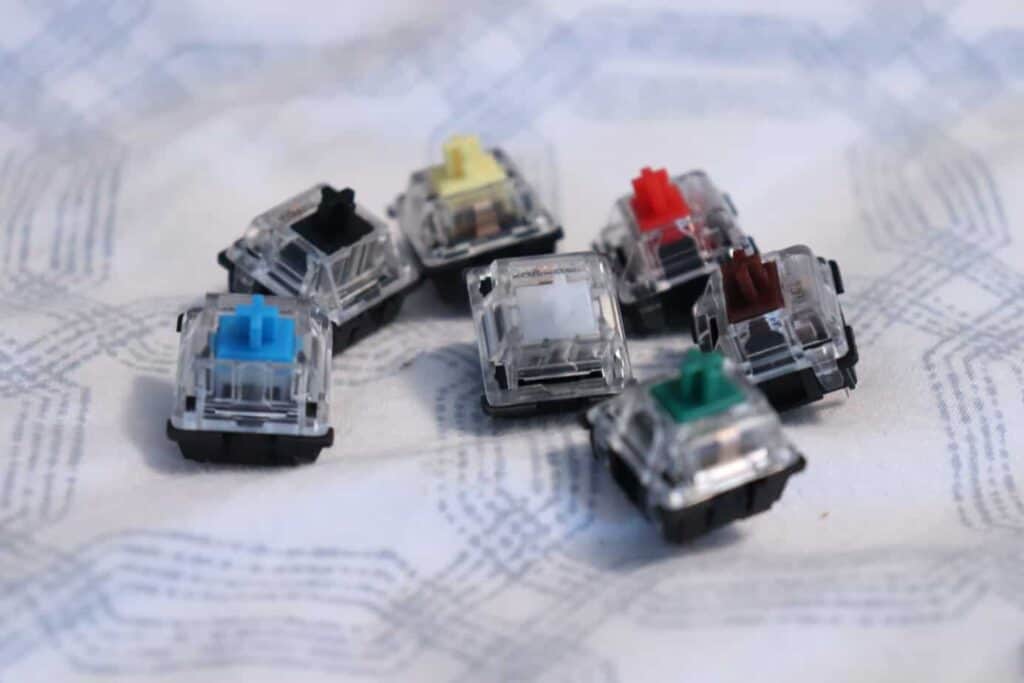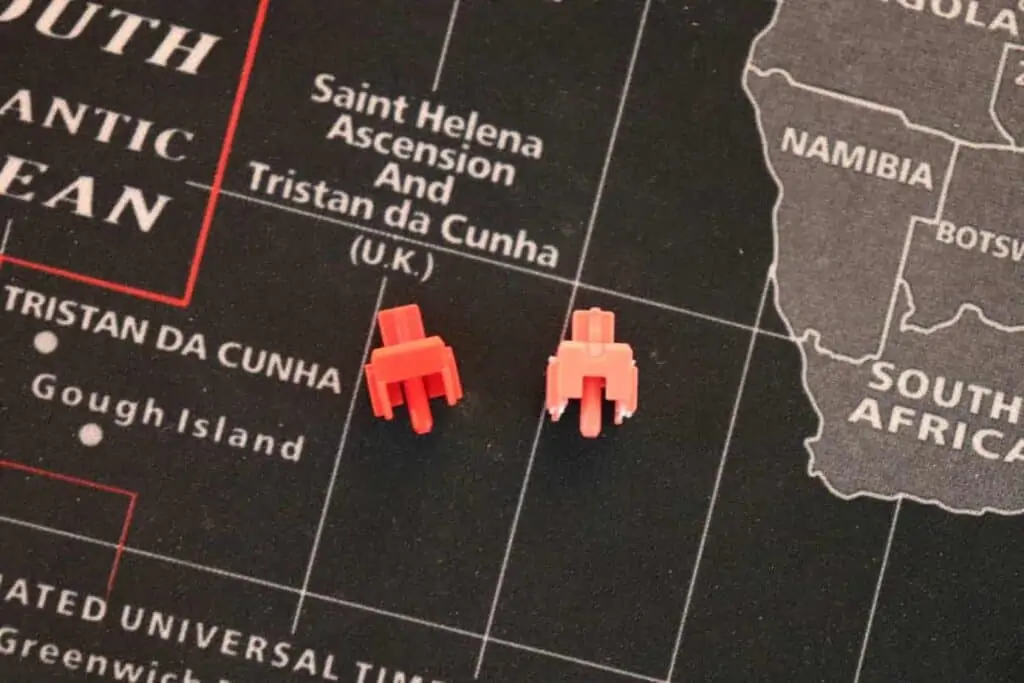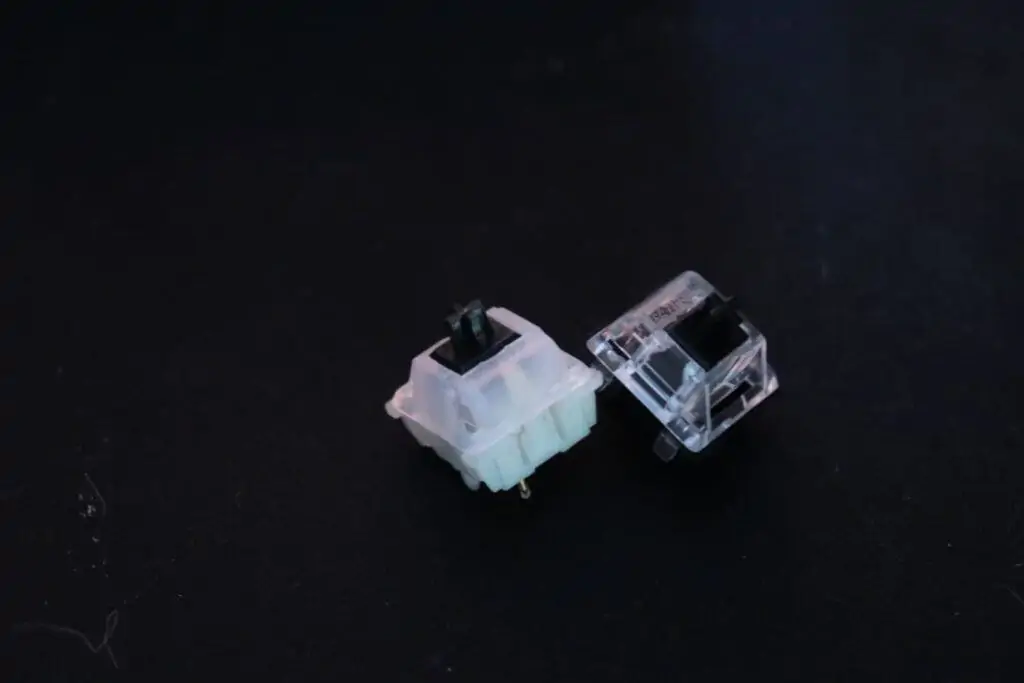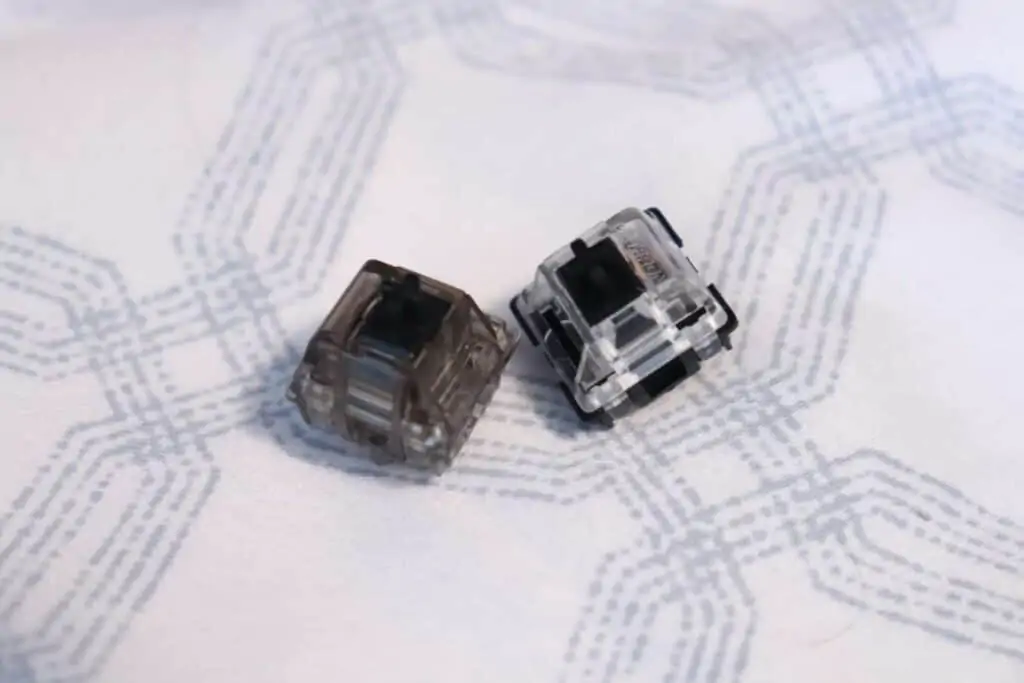Looking for the perfect switch for your keyboard?
While Gateron hasn’t had a reputation for being a premium switch, they offer the most budget-friendly options and are pound-for-pound one of the best switch options out there.
We’ll go over a full in-depth guide of Gateron’s entire switch lineup.
Gateron has dozens of switches available in its lineup including the standard Red, Blue, Brown, Green, Black, Yellow switches and their own unique Gateron Milk, Ink, Low-Profile, and Silent switch designs.
Regardless of the type of Gateron switch, you can rest assured that you will get a 50 million keystroke lifespan for each switch. Gateron is known to have some of the smoothest keystrokes on the market.

If you’re looking to purchase Gateron switches for your next build, you’re in the right place to figure out what’s the best for you.
We recommend the Kebo store for purchasing the switches.
We’ve tested out hundreds of switches, so we’ll also give you our thoughts on each style of Gateron switch to help you give an idea of how they feel and sound (along with our opinions).
Gateron Switches: A Deeper Look
As you can see from the table above, Gateron has a comprehensive lineup of switches that all offer a unique feel and aesthetic.
The main lineup is based on the Cherry MX switches, while the rest are more adventurous and interesting. Gateron has designed several additional switches such as their own silent switches, milk switches, ink switches, and low-profile switches. We’ll explain the differences below.
The Main Line-Up
| COLOR | TYPE | OPERATING FORCE | ACTIVATION POINT | NOISE LEVEL |
| Clear | Linear | 35cN | 2mm | Low |
| Red | Linear | 45cN | 2mm | Low |
| Yellow | Linear | 50cN | 2mm | Low |
| Black | Linear | 60cN | 2mm | Low |
| Blue | Clicky | 60cN | 2.3mm | Loud |
| Green | Clicky | 80cN | 2.4mm | Loud |
| Brown | Tactile | 55cN | 2mm | Medium |
The main Gateron switch lineup consists of the typical switches: Red, Blue, Brown, etc.
All of the switches in this classification are considered “clones” since they mirror the design of the Cherry MX switch and use the same descriptive names where the colors represent the actuation type and spring force.
The only switch that differs slightly is the Gateron Clear switch which is totally different from the Cherry MX Clear. Instead of being a heavy tactile, the Gateron Clear is a super-light linear switch.
While being Cherry MX clones, Gateron’s main switch lineup does differ slightly from Cherry MX. Gateron switches are typically smoother due to a slightly smaller stem which can make using a Gateron linear switch much more enjoyable than a Cherry MX one.
For that reason, if you’re thinking about getting a Gateron switch we recommend going with a linear actuating switch.
Gateron switches are not rated as high for durability as Cherry MX. Due to their rigorous testing and standards, Cherry MX switches are rated for 100 million keystrokes, while Gateron are 50 million.
The extra durability of Cherry MX switches is nice, but if you’re looking for the best feel and sound, you can’t beat Gateron linear switches.
You can browse the different switch options here.
Gateron Silent Switches
| COLOR | TYPE | OPERATING FORCE | ACTIVATION POINT | NOISE LEVEL |
| Silent Clear | Linear | 35cN | 2mm | Silent |
| Silent Red | Linear | 45cN | 2mm | Silent |
| Silent Yellow | Linear | 50cN | 2mm | Silent |
| Silent Black | Linear | 60cN | 2mm | Silent |
| Silent Brown | Tactile | 45cN | 2mm | Silent |
Gateron took another idea out of Cherry MX’s playbook when designing their silent switches. A silent switch is different from a normal switch because the stem has small rubber padding on the top and bottom, so the sound is dampened when striking and bouncing back.
The sound levels with a silent switch are significantly lower, in a test we found that silent switches are 16% more quiet than a normal switch.

Cherry MX only currently offers a Silent Black and Red switch while Gateron offers many more options.
Due to the smoothness of Gateron switches, we definitely prefer their silent switches to other switches.
Some keyboard users are not a fan of silent switches due to the rubbery feel when logging a keystroke and the fact that the sound is muted, while others really enjoy this aspect of the switch.
We recommend trying out a silent switch before getting a keyboard fitted with these switches.
You can check the availability of the silent switches here.
Gateron Milk Switches
| COLOR | TYPE | OPERATING FORCE | ACTIVATION POINT | NOISE LEVEL |
| Milk Clear | Linear | 35cN | 2mm | Low |
| Milk Red | Linear | 45cN | 2mm | Low |
| Milk Yellow | Linear | 50cN | 2mm | Low |
| Milk Black | Linear | 60cN | 2mm | Low |
| Milk Blue | Clicky | 60cN | 2.3mm | Loud |
| Milk Green | Clicky | 80cN | 2.4mm | Loud |
| Milk Brown | Tactile | 55cN | 2mm | Medium |
Gateron Milk switches are pretty interesting. They are very similar to normal Gateron switches except they come with a different housing design. Instead of the typical clear top housing and black bottom housing, the milk switches come with a “milky” tinted housing that help diffuse the RGB lights.

The normal switch housing directs RGB lighting directly into your eyes, while the milk switches give it a less intense feel. The overall sound and feel of Milk switches are the same except the color of the housing is different.
Gateron Ink Switches
| COLOR | TYPE | OPERATING FORCE | ACTIVATION POINT | NOISE LEVEL |
| Ink Red | Linear | 45cN | 2mm | Low |
| Ink Yellow | Linear | 50cN | 2mm | Low |
| Ink Black | Linear | 60cN | 2mm | Low |
| Ink Blue | Clicky | 60cN | 2.3mm | Loud |
| Silent Ink Black | Linear | 60cN | 2mm | Silent |
Gateron Ink switches are a bit different from the normal Gateron switch, they are what we would consider Gateron’s “premium switch” due to the higher price point.
The hallmark differences of the Ink switches are the clear smoky housing, different plastic material, lower pitch sound, and smoother feel.
The smoky housing is what gives the Ink’s their name, both the lower and upper housing are the same colors depending on what type of switch you use.
For example, the Ink Yellow will come with a smoky yellow housing while the black will be a clear smoky black color.

The plastic is different for the Inks although Gateron will not release the specifics. We can tell by the feel that the plastic most likely has a lower coefficient of friction due to the increased smoothness of the keystroke.
Overall, the ink switches are a great way to get a different colored housing and a super smooth keystroke if you’re willing to pay the premium.
Gateron Low-Profile Switches
| COLOR | TYPE | OPERATING FORCE | ACTIVATION POINT | NOISE LEVEL |
| Low-Profile Red | Linear | 45cN | 1.5mm | Low |
| Low-Profile Brown | Tactile | 55cN | 1.5mm | Medium |
| Low-Profile Blue | Clicky | 50cN | 1.5mm | Loud |
Gateron low profile switches have a completely different design than a normal switch. Gateron low-profile switches have a different shaped stem and a much short actuation and travel distance.
The benefits of this switch design are the fact that they allow a mechanical keyboard to be designed to be thinner and have a shorter actuation distance, which is in theory is faster for gaming.

The shorter actuation in my experience is more uncomfortable to type on, but some enjoy this design because a thinner keyboard may feel easier on their wrists.
Others use low-profile switches purely for gaming purposes because of the lower actuation distance, but based on a test that I did, I found no improvement when using a shorter actuation distance for gaming.
One of our favorite keyboards out-fitted with Gateron low-profile switches is the Keychron K1v4.
Which Gateron Switch is the Best?
The best Gateron switch is based on personal preference. Gateron’s signature is an extremely smooth keystroke, so we recommend trying out one of the Gateron linear switches such as a Red, Yellow, or Black switch. The Gateron ink switches are extra smooth, so we would rank them as the best if we had to choose.
Picking out the best switch is sort of like me picking out your favorite color, everybody has different ideas of what they want from a switch.
If you’re looking at Gateron switches though it’s hard to pass up on the linear switches, due to the smoothness.
If you’re looking for a tactile or clicky switch there are better switch manufacturers out there that make these switch types better.
Key Factors in Choosing your Gateron Switch
Purpose of Usage
Whether you’re a gamer, programmer, typist, or anything else under the sun, you can find a switch that will work for you. There are a few different factors to consider before deciding on a switch.
Environmental Considerations
You might not initially think where you have your keyboard matters much in the way of choosing between types of switches, but it certainly does. Some keyboard switches have a click-clack sound, which may be appealing to your sensibilities, but absolutely annoying to those around you.
Before picking a loud switch, you must consider your surroundings. Where are you using this keyboard? Clicky keys are pleasing for the user, not listeners. Therefore, if you’re looking to replace your keyboard switches, we recommend going with a softer switch like the Gateron Clear or the Gateron Black if you want a heavier feel).
Avoid typing on clicky switches in public spaces such as the office or library, instead limit to strictly home usage (unless they drive your spouse crazy).
The Touch & Sound
The click-clack of a clicky mechanical switch is nostalgic. It takes you back to the 80s and 90s keyboards of yore’. If you need that satisfying punch and resounding ‘click’ as you type, you’ll want to check out Gateron’s clicky switches (Blue or Green).
Understanding the Mechanical Switch Features

As you can see in the Gateron mechanical switch comparison chart, there are multiple discerning features to each switch. It’s important to understand what each means in order to best choose the Gateron switches most suitable to your needs.
- Actuation Type – This indicates the behavior of the key and whether it is linear, tactile, or clicky. Whether the keystroke is smooth, bumpy, or loud will determine its classification.
- Operating Force – this refers to the force required to make the key press down and register the keystroke to the computer. I.e.: how hard you must press the key. This measurement of (cN) refers to centinewtons.
- Activation Point – this indicates at which point the switch is pressed down hard enough to translate information from keyboard to computer. Most switches will have an actuation point of around 2mm unless the switch is low-profile, in which case the activation point is shorter. This pressure point is measured in millimeters (mm).
- Travel Distance – the travel distance of a switch is the distance from the top of the key (un-pressed) to the bottom of the key (when pressed all the way down.) The point at which the switch is fully bottomed out is the end of the travel distance. It is also measured in millimeters (mm).
- Lifespan – this refers to the number of keystrokes that can be made before the switch deviates from its factory conditions. Most switches will actually last longer than the lifespan, and many prefer the feel of a well-used switch to a brand new one. A well-used switch will often have a less scratchy feel and will have a better sound. All the aforementioned Gateron switches have a 50 million keystroke lifespan.
The Key Take Away
There is an endless amount of ways to utilize Gateron switches of any color because Gateron switches are designed to meet a plethora of needs.
Whether you’re looking for a light as a feather stroke to ease finger strain, or looking to dive into 80’s nostalgia with a clicky, bumpy switch, Gateron has different options available.
If you want the lightest possible touch, we recommend the Gateron clear switch. If gaming is what you have in mind, then the red or black Gateron switches are your best bet.
The Gateron specialty switches are where things get especially interesting. The different housing designs of the Milk and Ink switches really bring a unique design to the playing field and allows Gateron to show everybody they are more than just a Cherry MX clone company.
If you’re willing to pay a little extra we definitely recommend checking out the Gateron Ink lineup for some extra smooth switches.
Happy Typing!
